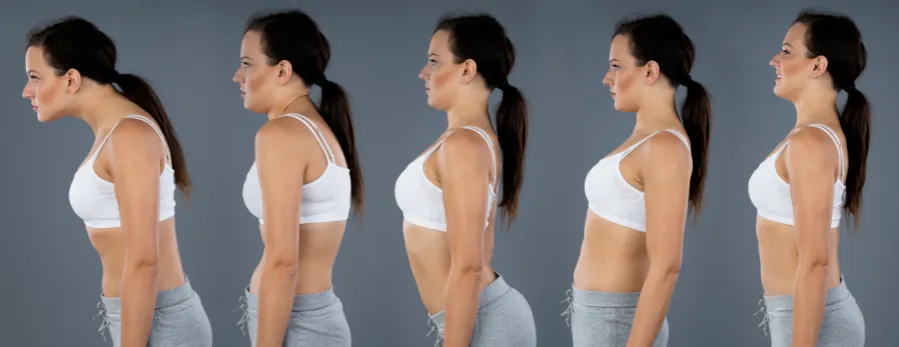
We all know that good posture is essential for maintaining a healthy and confident appearance. But did you know that your posture can have far-reaching consequences for your health? In fact, recent studies from New Zealand have shed light on how our posture affects various aspects of both our physical and mental health.
At Connect Chiropractic, we often see patients with postural problems that significantly impact their spinal health and overall wellbeing. In this blog post, we’ll explore four common postural issues:
- “Text Neck”
- Hyperkyphosis and Dowager’s Hump
- Flat Back
- Swayback
Understanding these conditions can help you recognize their symptoms and seek appropriate care to improve your posture, spinal alignment – and life!
Hyperkyphosis and Dowager’s Hump
Hyperkyphosis, often accompanied by Dowager’s Hump, refers to a severe spinal curve in the upper back that can exceed fifty degrees, approximately ten degrees more than a “normal” curve. Patients with this condition typically exhibit a forward head posture, straightened neck curve, rounded shoulders, and an excessive curve between the thoracic and lumbar regions.
Dowager’s Hump is more commonly diagnosed in women over forty, as changes in bone density and hormonal shifts during menopause can weaken their spinal vertebrae. This can lead to discomfort and reduced mobility, making it essential to address through proper treatment and preventive measures.
Flat Back
A correct spinal posture will have a gentle “S curve” when viewed from the side. But people with “flat back” may experience a loss of the natural curve in the bottom (lumbar) portion of their spine. As a result, their head leans forward, and they may develop stooped shoulders.
This postural imbalance can lead to discomfort and pain. If you are concerned about this, seek professional guidance for corrective exercises that can help restore your natural spinal curvature and alleviate associated symptoms.
Swayback (Lordosis)
Swayback, also known as Lordosis, refers to an exaggerated “S curve” in the spine when observed from the side. The spine curves inwards in the lower back and neck regions, causing symptoms such as back pain, reduced mobility, a potbelly, and buttocks that stick out.
Proper diagnosis and personalized treatment plans, including Chiropractic care and targeted exercises, can help to reduce pain and improve posture.
“Text Neck”
One specific posture issue that we see more and more often in the clinic is forward head posture, often referred to as “text neck.” When your head is positioned in front of your spine, it creates a substantial burden on the muscles, ligaments, and joints at the back of your neck. This excess weight, equivalent to a bowling ball, can strain the spine and lead to chronic pain and discomfort.
Alarmingly, an increasing number of younger people are experiencing “text neck” due to prolonged use of technology like smartphones and tablets.
The Lifelong Impact of Children’s Spines
It is crucial to address “tech neck” in children and teenagers to ensure their spine remains healthy. Research shows that spinal dysfunction and pain experienced during teenage years often persists into adulthood. So to prevent long-term problems, parents and caregivers must take proactive steps to promote good posture habits in their children.
Encouraging simple solutions, such as having kids lie on their stomachs when using smart devices, can make a significant difference in maintaining correct posture.
Posture and Stress
A fascinating study[1] recently conducted in New Zealand revealed a surprising link between your posture and your ability to cope with stress. Researchers found that maintaining an upright “good” posture, compared to being in a slouched position, during stressful tasks will significantly improve your coping abilities.
Impact on Mental Health and Resilience
Another study[2] from the University of Auckland focused on the effects of posture on young, healthy individuals during a stressful reading task.
Subjects held in an upright “good” posture displayed and felt higher self-esteem, better mood, and lower fear levels compared to those in a slumped posture. This shows that maintaining good posture not only benefits our breathing but also boosts self-confidence and resilience when we face stressful situations.
Recognizing common postural problems is essential for the maintenance of our spinal health. Seeking Chiropractic care can help to address these issues and prevent long-term complications. Also, by instilling healthy posture habits in our children, we can take proactive steps to improve posture, mobility, and overall wellbeing, thus paving the way for a healthier future.
If you are concerned about your posture or wish to have your spine and posture checked, book an appointment with one of our chiropractors at Connect Chiropractic on 03 9512 5882 or www.connectchiropractic.com.au
[1] Bradley H, Esformes J. Breathing pattern disorders and functional movement. Int J Sports Phys Ther. Feb 2014;9(1):28-39.
[2] Fernández-de-Las-Peñas, C., Cuadrado, M. L., & Pareja, J. A. (2006). Myofascial trigger points, neck mobility and forward head posture in unilateral migraine. Cephalalgia, 26(9), 1061-1070.





